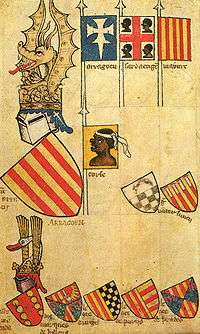Maure
A Maure, since the 11th century, is the symbol of a Moor's head. The term has Phoenician and Greek origins; see Moors.
Flags, seals, and emblems
This symbol is used for political purposes.
The Maure
The Maure is the African Unification Front's flag and emblem.
Flag of Corsica

The main charge in the coat of arms in Corsica is U Moru, Corsican for "The Moor", originally a female Moor blindfolded and wearing a necklace made of beads. An early version is attested in the 14th-century Gelre Armorial, where an unblindfolded Moor's head represents Corsica as a state of the Crown of Aragon. In 1736, it was used by both sides during the struggle for independence.
In 1760, General Pasquale Paoli ordered the necklace to be removed from the head and the blindfold raised. His reason, reported by his biographers, was "Les Corses veulent y voir clair. La liberté doit marcher au flambeau de la philosophie. Ne dirait-on pas que nous craignons la lumière ?" (English: "The Corsicans want to see clearly. Freedom must walk by the torch of philosophy. Won't they say that we fear the light?") Later the blindfold was changed to a headband.
The current flag of Corsica is the Bandera testa Mora ("Flag with head of Maure"), is male rather than female, and has a regular knot at the back of the head.
Flag of Sardinia



The flag of Sardinia is informally known as the Four Moors (Italian: I quattro mori, Logudorese: Sos Bator Moros, Campidanese: Is Cuatru Morus) and comprises four Moor heads. The origin of these figures on the flag is disputed. The fact that the seal has varied across the centuries, with the Moors variously being blindfolded, bareheaded, crowned, close-eyed, open-eyed, and wearing headbands, and facing in various directions, has only increased confusion.
Some sources state that the flag is of Spanish origin and represents four Moorish invaders blindfolded for execution. However, the Sardinian Autonomous Region's web site proffers the explanation that whilst the emblem dates back to 1281, and can be seen on a seal of the Royal Chancellery of Peter the Great of Aragon, it was only in the 14th century, when the Kingdom of Sardinia became part of the Confederation of the Crown of Aragon, that the Four Moors came to be associated with Sardinia. It was not until the 18th century that the arrangement of the heads was fixed, with the Moors facing left and banded on their forehead. On July 2, 1952, by decree the emblem became the official symbol of the region, and on April 15, 1999, the official flag, but this time with the Moors facing the fly, wearing headbands, and with their eyes open.
Maure's symbology in Europe
The blackamoor appears in frescoes of Piero Della Francesca in the middle of the 15th century, flag of the hostile front of Costantin; in French and Germanic areas, until Estonia, it symbolizes Maurice and Victor, saints of African ancestry.
_-_Foto_Giovanni_Dall'Orto%2C_13-4-2006_01.jpg)
 1450, Piero della Francesco, Frescoes of True Cross, Arezzo
1450, Piero della Francesco, Frescoes of True Cross, Arezzo detail
detail Saint Maurice, Grunewald
Saint Maurice, Grunewald.jpg) Saint Maurice and Saint George - Hans Baldung Grien (c. 1484 – 1545)
Saint Maurice and Saint George - Hans Baldung Grien (c. 1484 – 1545).jpg) Saint Maurice, Lucas Cranach the Elder (Germany, 1472–1553)
Saint Maurice, Lucas Cranach the Elder (Germany, 1472–1553).jpg) Saint Victor, Saint Nicholas, Saint George and the blackamoor, Hermen Rode 1478–1481, St. Nicholas' Church, Tallinn, Estonia.
Saint Victor, Saint Nicholas, Saint George and the blackamoor, Hermen Rode 1478–1481, St. Nicholas' Church, Tallinn, Estonia. Facade of the House of Blackheads in Tallinn by Arent Passer.
Facade of the House of Blackheads in Tallinn by Arent Passer. Portal of the House of Blackheads in Riga (LV) with reliefs of St. Mary and Saint Mauritius.
Portal of the House of Blackheads in Riga (LV) with reliefs of St. Mary and Saint Mauritius. Gelre Armorial, Folio 62r, 14th century
Gelre Armorial, Folio 62r, 14th century
 Tucher von Simmelsdorf in Antwerp
Tucher von Simmelsdorf in Antwerp
 Coat of Georg Gänswein
Coat of Georg Gänswein
See also
- There are dozens of examples from Germany, viewable at the German Wikipedia article de:Mohr (Heraldik)
- Linkebeek, Belgium
References
- "Heart of Independent Sardinia". giampiero6's Orgosolo Page. Retrieved April 22, 2005.
- "Sa Bandela de Sos Bator Moros", Sardinian Autonomous Region, retrieved April 22, 2005 which in turn cites
- B. Fois (1990). Lo stemma dei quattro mori, breve storia dell'emblema dei Sardi. (editor Carlo Delfino) Sassari.
- "The Historic Significance of the Muare", African Unification Front, retrieved April 22, 2005
- "L'Histoire d'U Moru", Extraits de l'Ouvrage: "Trois Etudes Sur Paoli", retrieved April 22, 2005
- "U Moru (English translation)", Extracts from "Trois Etudes Sur Paoli", retrieved April 22, 2005
External links
-
 Media related to Moor heads at Wikimedia Commons
Media related to Moor heads at Wikimedia Commons